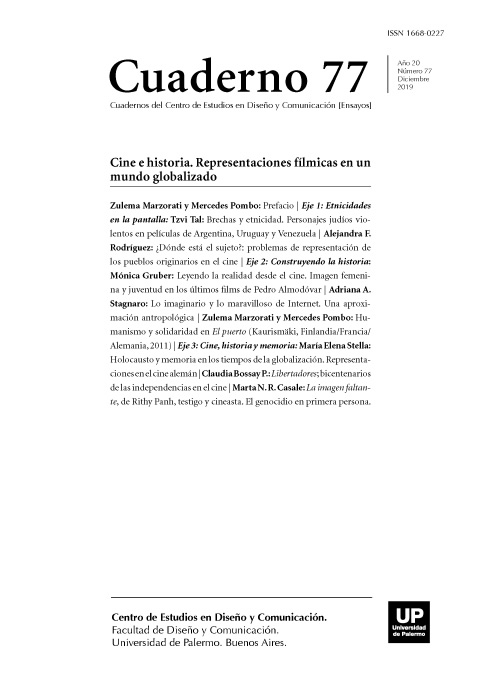Brechas y etnicidad. Personajes judíos violentos en películas de Argentina, Uruguay y Venezuela
Abstract
This article focuses on the novel appearance of violent Jewish characters in Latin American films from three societies crossed by deep social, political and discursive gaps: Argentina, Uruguay and Venezuela. Starting from the premise that the image of the Jew in the cinema can be read allegorically as an indicator of the processes of the National Identity, by pointing out the limits of cultural Inclusion and Exclusion, the article argues that this new type of cinematographic character expresses the anxiety caused by the polarization of the public discourse, that could unleash political violence. The threat is not represented by external factors, such as a xenophobic image of the new waves of migration in the era of Globalization, but within the National community itself, to whose imagined homogeneity the image of included Jewish Otherness has contributed. It refers to the films Diablo (Loreti, Argentina, 2011), Relatos Salvajes (Szifrón, Argentina, 2014), Reus (Piñeiro and Fernandez y Pi, (Uruguay, 2011), Ms. Kaplan (Brechner, Uruguay, 2014), Esclavo de Dios (Novoa (Argentina / Venezuela / Uruguay, 2013). Except for the first, all the rest were produced with the support of the Iberoamerican Audiovisual Program (Ibermedia).
References
Abrams, N. (2012). The New Jew in Film - Exploring Jewishness and Judaism in Contemporary Cinema. London and New York: I.B. Tauris.
Anderson, B. (1993). Comunidades imaginadas. México: Fondo de Cultura Económica, (1a. en inglés 1983).
Arenas, N. (2016). “El chavismo sin Chávez: la deriva de un populismo sin carisma”, Nueva Sociedad 261: 14-22.
Avellaneda, A. (2014). “Venezuela is Buried Under Division and Violence.” Caribbean Journal of International Relations and Diplomacy 1: 89 - 97.
Bartov, O. (2004). The “Jew” in Cinema - From The Golem to Don’t Touch My Holocaust, Bloomington: Indiana University Press.
Bhabha, H. (1990) (ed.). Nation and Narration, New York and London.
Coutoursie, R. (2008). “El cine uruguayo contemporáneo: desde El lugar del humo hasta Whisky: Crónica de un nacimiento anunciado”. Revista Nuestra América 6: 179-183.
Graff Zivin, E. (2008). The Wandering Signifier: Rhetoric of Jewishness in the Latin American Imaginary. Durham: Duke University Press.
Deleuze, G. y Guattari, F. (1997). Mil Mesetas. Capitalismo y esquizofrenia. Valencia: PreTextos.
Kellner, D. (1995). “Cultural Studies, Multiculturalism and Media Culture”, in: Dines, Gail and Humez, Jean M. (eds.), Gender, Race and Class in Media - A Text Reader, London: Sage, pp. 5-17.
Korstanje, M. (2016). “De la Crisis Financiera en 2001 a la Filosofía de la grieta: la política argentina contemporánea”. Reflexiones Marginales 33: http://reflexionesmarginales.com/3.0/de-la-crisis-financiera-en-2001-a-la-filosofia-de-la-grieta-la-politica-argentinacontemporanea/. Consultado 15/7/2016.
Kourliandsky, J.-J. (2013). “Irán y América Latina: más cerca por una coyuntura de futuro incierto”, Nueva Sociedad 246: 144-158.
Moya Mena, S. I. “Las relaciones entre Irán y América Latina después de Chávez y Ahmadinejad”, Centro de Estudios de Medio Oriente y África del Norte, San José: Universidad Nacional de Costa Rica. web.isanet.org/.../814f7b99-7f55-432d-a176-6c46fc28ee4a.pdf. Consultado 15/07/2017.
Naficy, H. (2001). An Accented Cinema - Exilic and Diasporic Filmmaking. New Jersey: Princeton University Press,.
Manvel, N. “La polémica de la película venezolana Esclavo de Dios: Podría ser retirada de la cartelera por boicot”, Noticias24 04/07/2013, http://www.noticias24.com/venezuela/noticia/178700/la-polemica-de-la-pelicula-venezolana-esclavo-de-dios-podria-serretirada-de-la-cartelera-por-boicot-fotos-y-video/. Consultado 17/07/2017.
Olmo, G. D.,“Los judíos de Venezuela, entre la tolerancia social y el antisionismo chavista”, ABC Internacional, 16/04/2014. http://www.abc.es/internacional/20140416/abci-judiosvenezuela-chavismo-201403211855.html. Consultado 15/07/2017.
Pintos García, M. (2015). “Apuntes sobre pobreza, cultura y políticas sociales en el Uruguay actual. La etnologización de los pobres”, Fronteras 8: 89-103.
Radakovich, R. (2013). “Cine nacional en Uruguay”, ponencia en Congreso Asociación Latinoamericana de Sociología, Chile: http://actacientifica.servicioit.cl/biblioteca/gt/GT3/GT3_RadakovichR.pdf. Consultado 15/7/2016.
Rosenberg, J. and Whitfield, S. (2002). “The Cinema of Jewish Experience: Introduction”, Prooftexts 22: 1-10.
Serfaty, I. N. y Garrido, N. L., “Sobre la emigración de venezolanos judíos a Israel: matices de una compleja realidad”, Nuevo Mundo Israelita 16/01/2017, http://www.nmidigital.com/sobre-la-emigracion-de-venezolanos-judios-israel-matices-de-una-compleja-realidad/. Consultado 16/07/2017.
Silva, N., “Diablo”, http://hacerselacritica.blogspot.co.il/2012/12/diablo-de-nicanor-loreti. html. Consultado 28/2/2015;
Tabarrozi, M. (2007). “Representaciones de lo identitario e ideología estética en el cine de Leonardo Favio, Fernando Solanas, Leopoldo Torre Nilsson y Alejandro Agreste”, ponencia en Jornadas de Investigación en Disciplinas Artísticas y Proyectuales, Universidad de La Plata, http://sedici.unlp.edu.ar/handle/10915/39370. Consultado 15/07/2017.
Tal, T. (2005). “Alegorías de memoria y olvido en películas de iniciación: Machuca y Kamchatka”, Aisthesis 38: 136-151.
__________. (2008). “Migración y memoria: la reconstrucción de la identidad de judíos y palestinos en películas recientes de Chile y Argentina”, in: Arabes y judíos en Iberoamérica Similitudes, diferencias y tensiones, Raanan Rein (coord.), Sevilla: Fundación Tres Culturas del Mediterráneo, pp. 417-438.
__________. (2010). Terror, etnicidad y la imagen del judío en el cine argentino contemporáneo”, NuevoMundo Nuevos Mundos: http://nuevomundo.revues.org/index58355.html. Consultado 15/7/2016.
__________. (2003). “Cine y Revolución in ‘la Suiza de América’ - La Cinemateca del Tercer Mundo en Montevideo”. Araucaria 4: 70-92.
__________. (2013). “Etnicidad y espacio público: la imagen del judío en películas de México y Chile”, EIAL 1: 65-82.
Vieytes, M., “¿Un cine anarco/peronista?”, http://hacerselacritica.blogspot.com.ar/2012/12/un-cine-anarcoperonista-diablo-caetano.html. Consultado 28/2/2015.
Xavier, I. (1999). “Allegory and History”, in: Robert Stam and Toby Millar (eds.) A Companion to Film Theory, Malden: Blackwell, pp. 333-362.
Los autores/as que publiquen en esta revista ceden los derechos de autor y de publicación a "Cuadernos del Centro de Estudios de Diseño y Comunicación", Aceptando el registro de su trabajo bajo una licencia de atribución de Creative Commons, que permite a terceros utilizar lo publicado siempre que de el crédito pertinente a los autores y a esta revista.


